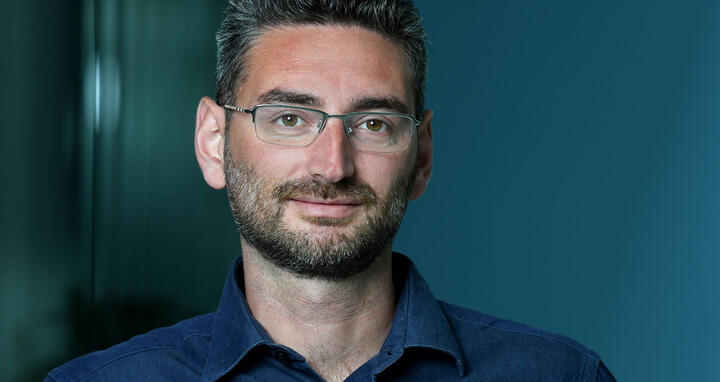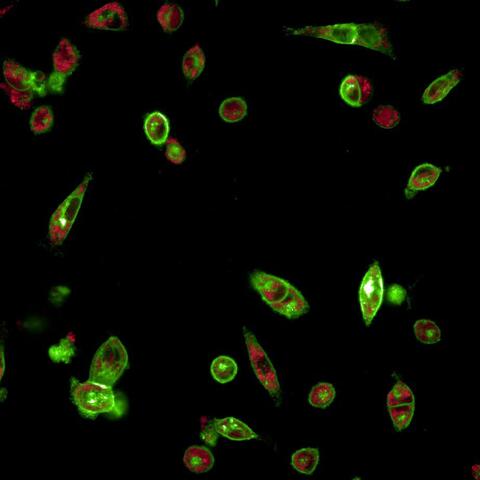ERC Proof of Concept Grant for Gaetano Gargiulo
Cancer cells deceive the body in insidious ways. Not only do they change their DNA and thus become more diverse, they can also change states over and over again. “If you want to tackle cancer cells with precise therapies, you have to take into account all their heterogeneity and factor in possible evasive maneuvers,” says Dr. Gaetano Gargiulo, head of the Molecular Oncology Lab at the Max Delbrück Center for Molecular Medicine in the Helmholtz Association (MDC). It is becoming increasingly clear that cell states are an essential part of this process. He and his colleagues have invented a technology that can visualize and document the transitions from one cell state to another.
If you want to tackle cancer cells with precise therapies, you have to take into account all their heterogeneity and factor in possible evasive maneuvers.
The cells of many solid tumors, including common cancers like those of the lung, breast, colon and pancreas, take advantage of a cellular program that occurs in embryonic development: epithelial-mesenchymal transition (EMT). When epithelial tumor cells transition into the mesenchymal state, they can travel through the body more easily and respond to anti-cancer therapies differently. Using their new technology, Gargiulo and his team were able to show, for example, that immune cells can become collaborators in this process. They help glioblastoma cells in the brain transition to a mesenchymal state and thus become resistant to chemotherapy. The team has also followed these cell state changes in lung cancer. “And they are hardly a one-way street,” Gargiulo says.
The invention of the molecular reporters that visualize the transition was part of a project that the European Research Council (ERC) is already funding with a Starting Grant. Gargiulo and his team quickly realized that the technology was not only relevant to their own research questions, but also could make the search for new drugs against cancer more effective. The ERC shares this view and is now funding the first steps toward commercialization of the discovery with a Proof of Concept (PoC) Grant of €150,000. Gargiulo is one of 166 researchers from all over Europe who is receiving PoC funding this year, paving the way for them to translate their findings into broadly applied solutions.
Searching more efficiently for new cancer drugs
Lung cancer cells as they transition from epithelial to mesenchymal phenotype, made visible by the green fluorescence of the molecular reporter.
Garguilo’s project aims to improve the high-throughput methods that scientists and the pharmaceutical industry use to search for new cancer drugs. Established cell lines are the standard models for testing large compound libraries in one screening. “However, this approach is currently oversimplified, as information on cell states is neither obtained nor accounted for in the process,” Gargiulo says. “Yet cell states have a profound impact on whether therapeutics can be effective or not. And there is consensus that in the future a combination of different agents will be employed to prevent possible evasive maneuvers.” With the help of the PoC Grant, he and his colleagues now intend to develop a toolbox that makes molecular reporters available for frequently used cell lines. They also want to specify the culture media in such a way that they purposefully push the cells into one state or another.
“As scientists, we can develop a prototype,” Gargiulo says, “but that’s only one step toward broad implementation.” Intellectual property expertise and a strategy that promotes discovery value creation, he says, are also essential – for example in collaboration with the MDC’s technology transfer team. “The ERC grant gives us time to focus on these steps. It’s an important boost.” He is convinced it will be pay off. After all, shortcomings in drug development currently eat up billions of euros and small optimizations might have a significant impact on the economy and society – and on the countless patients who need effective therapies.
Further information
- Molecular reporters expose the allies of the brain tumor
- A gearbox for tumor cell identity changes
- ERC press release
Downloadable image
Profile of Gaetano Gargiulo. Photo: David Ausserhofer, MDC
Contacts
Dr. Gaetano Gargiulo
Head of the Molecular Oncology Lab
Max Delbrück Center for Molecular Medicine in the Helmholtz Association (MDC)
+49(0)30-9406-3861
Gaetano.Gargiulo@mdc-berlin.de
Jana Schlütter
Editor, Communications Department
Max Delbrück Center for Molecular Medicine in the Helmholtz Association (MDC)+49 30 9406-2121
jana.schluetter@mdc-berlin.de or presse@mdc-berlin.de
Max Delbrück Center for Molecular Medicine in the Helmholtz Association (MDC)
The Max Delbrück Center for Molecular Medicine in the Helmholtz Association (MDC) is one of the world’s leading biomedical research institutions. Max Delbrück, a Berlin native, was a Nobel laureate and one of the founders of molecular biology. At the MDC’s locations in Berlin-Buch and Mitte, researchers from some 60 countries analyze the human system – investigating the biological foundations of life from its most elementary building blocks to systems-wide mechanisms. By understanding what regulates or disrupts the dynamic equilibrium in a cell, an organ, or the entire body, we can prevent diseases, diagnose them earlier, and stop their progression with tailored therapies. Patients should benefit as soon as possible from basic research discoveries. The MDC therefore supports spin-off creation and participates in collaborative networks. It works in close partnership with Charité – Universitätsmedizin Berlin in the jointly run Experimental and Clinical Research Center (ECRC), the Berlin Institute of Health (BIH) at Charité, and the German Center for Cardiovascular Research (DZHK). Founded in 1992, the MDC today employs 1,600 people and is funded 90 percent by the German federal government and 10 percent by the State of Berlin.







